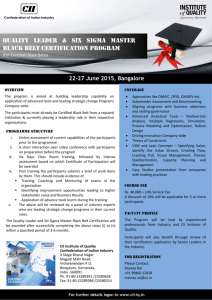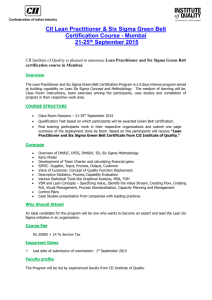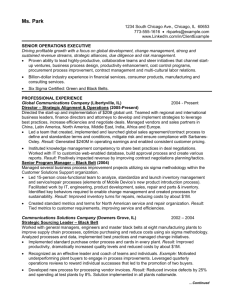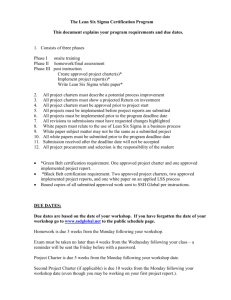Green Belt Course Agenda - Asheville
advertisement
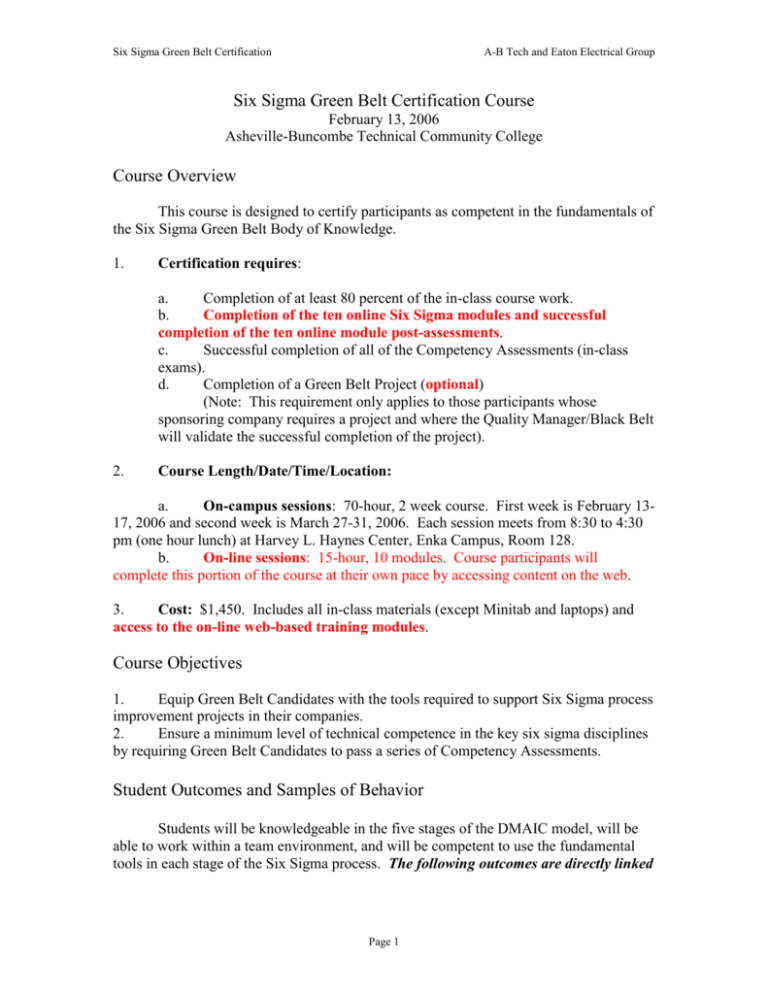
Six Sigma Green Belt Certification A-B Tech and Eaton Electrical Group Six Sigma Green Belt Certification Course February 13, 2006 Asheville-Buncombe Technical Community College Course Overview This course is designed to certify participants as competent in the fundamentals of the Six Sigma Green Belt Body of Knowledge. 1. Certification requires: a. Completion of at least 80 percent of the in-class course work. b. Completion of the ten online Six Sigma modules and successful completion of the ten online module post-assessments. c. Successful completion of all of the Competency Assessments (in-class exams). d. Completion of a Green Belt Project (optional) (Note: This requirement only applies to those participants whose sponsoring company requires a project and where the Quality Manager/Black Belt will validate the successful completion of the project). 2. Course Length/Date/Time/Location: a. On-campus sessions: 70-hour, 2 week course. First week is February 1317, 2006 and second week is March 27-31, 2006. Each session meets from 8:30 to 4:30 pm (one hour lunch) at Harvey L. Haynes Center, Enka Campus, Room 128. b. On-line sessions: 15-hour, 10 modules. Course participants will complete this portion of the course at their own pace by accessing content on the web. 3. Cost: $1,450. Includes all in-class materials (except Minitab and laptops) and access to the on-line web-based training modules. Course Objectives 1. Equip Green Belt Candidates with the tools required to support Six Sigma process improvement projects in their companies. 2. Ensure a minimum level of technical competence in the key six sigma disciplines by requiring Green Belt Candidates to pass a series of Competency Assessments. Student Outcomes and Samples of Behavior Students will be knowledgeable in the five stages of the DMAIC model, will be able to work within a team environment, and will be competent to use the fundamental tools in each stage of the Six Sigma process. The following outcomes are directly linked Page 1 Six Sigma Green Belt Certification A-B Tech and Eaton Electrical Group to the key course exercises and competency assessments (i.e. exams). Each participant, upon completion of this course, will be able to: 1. Breakdown a process into its component steps and organize them into a basic process flowchart. 2. Determine the measurement requirements for a simple project and setup a data collection process. 3. Perform and interpret a Gage R&R Study (both variables and attributes) 4. Calculate DPMO and Six Sigma for a process output. 5. Conduct a simple Capability Study 6. Setup, conduct and interpret a scatter diagram for paired data. 7. Develop, conduct and interpret a stratification analysis using ANOVA 8. Conduct and interpret a one-sample t-test. 9. Conduct and interpret a two-sample proportion test. 10. Calculate the Correlation Coefficient for paired data. 11. Build a simple process improvement plan based on results of analysis. 12. Setup, construct and interpret simple control charts (X-Bar and R charts). Course Materials 1. Three-ring binder (slide copies and exercise materials) 2. Primary textbook: The Six Sigma Way Team Fieldbook, by Pande, Neumann, and Cavanagh. 3. Reference textbook: Lean Six Sigma Pocket Toolbook, by the George Group 4. On-line, web-based training modules. Course Developer and Instructor: Douglas Jones. Credentials Master of Science in Systems Management, University of Southern California. SigmaPro certified Six Sigma Master Black Belt. ASQ Certified Six Sigma Black Belt (CSSBB), Certified Quality Engineer (CQE), Certified Quality Manager (CQMgr), Certified Quality Auditor (CQA). QSA/Registrar Accreditation Board (RAB) Certified Quality Management System Auditor (QMS-A) for ISO 9001:2000. Note: On-line materials were developed by The Quality Group. Requirements/Prerequisites: Laptop with Minitab Version 14 Participants are encouraged to have a laptop with Minitab 14. For those without a laptop, the Productivity Institute has laptops (with Minitab) for student use while in the classroom. It is highly recommended that all participants be familiar with how to use the Minitab Statistical Software. For Green Belt candidates not familiar with Minitab, they may gain this familiarity by attending the “Introduction to Minitab” course. Minitab Version 14 (30-day trial version) is available for students to use on their own laptops/desktops if they don’t yet have Minitab at the start of the course. Page 2 Six Sigma Green Belt Certification A-B Tech and Eaton Electrical Group Recommended but not required: 1. 2. Minitab “Basic Statistics” course. Minitab “Statistical Quality Analysis” course. To register: Call/email Doug Jones at 828-254-1921 Ext 5822, djones@abtech.edu. Or go to https://sr.coned.abtech.edu/welcome.htm for on-line registration and enter course ID SEF-7000-011 in the course registration sheet. Seating is limited. Course Content and Structure: 1. In-class training (lectures, workbook and exercises) will follow the structure of The Six Sigma Way Team Fieldbook. Hands-on exercises will be used throughout and analytical work will utilize a combination of manual computational methods and Minitab Statistical Software. 2. Three extended cases studies/micro-labs are used as the primary method for organizing/structuring classroom exercises and summarizing key learning outcomes. These are: a. Damper Scrap Case Study. This is a completed Black Belt project summarized in a 40-page report that is included in the student binder. It is used as a tool to summarize “key learning outcomes” at the end of each stage of the DMAIC process. b. PageGrabber Corporation Product Return Project. The project is an in-class six sigma project used in exploring the DEFINE-MEASURE-ANALYSIS stages of the DMAIC process. Students are presented with the problem of a “sharp spike in product returns by a key customer”. Using the skills developed in the class, they work in small teams to clearly define the problem; set up and conduct a measurement plan; and conduct a preliminary analysis of the data. Exercises in the course agenda are tied directly to this project. c. Statapult Project. This project uses the classic Statapult machine (i.e. a catapult used in statistical studies) to model a process that is producing an output that does not meet customer requirements. Students work on this project through all stages of the DMAIC process. Exercises in the course agenda are tied directly to this project. 3. On-line web-based instructional modules. These 10 modules will take participants approximately 15 hours to complete at their own pace. These modules will provide information that will help participants better understand the six sigma principles, concepts and statistics. The intent is to reinforce and clarify the material being covered during weekly in-class lectures and exercises. Page 3 Six Sigma Green Belt Certification A-B Tech and Eaton Electrical Group 4. Focus is on technical skills required by a Green Belt. Some formal team training will be included in the course material; however, most of the team skills will be embedded in and assessed as part of the technical exercises. Rationale: Limited time requires the concentration of course hours on developing technical capability; and, most companies have adequate internal assets to provide excellent team training. 5. There will not be an outside class-directed project. Participants are expected/encouraged to work on company projects as directed by their own black belts/quality managers. Rationale: Individual projects are NEVER in sync with what is being taught in class (they are either ahead or behind the classroom material), so external projects will not be an integrated part of the curriculum. However, company quality managers/black belts may require their participants to complete a Green Belt Project before receiving certification. 6. Exams will be used to assess competency. Exams (different versions) can be taken up to three times to demonstrate competency in each technical area (i.e. this is not a one-chance-or-you-fail system). Demonstrated competence in the Green Belt body of knowledge is required for certification. Green Belt Course Agenda (in-class sessions) 1. Module 1: Introduction A. The Six Sigma Way 1) 2) 3) B. Three Ways to Six Sigma 1) 2) 3) ` 2. Six Sigma: What is it? System Alignment: Tracking the Xs and Ys Six Ingredients of Six Sigma Process Improvement: Finding Target Solutions Process Design/Redesign Process Management for Six Sigma Leadership C. Organizing for Six Sigma: The Seven Roles D. The Team Leader’s Toolkit 1) 2) 3) 4) 5) Team dynamics and evolution Team Facilitation Basic Discussion Skills Data Collection: Using the Right Tools Organizational Communication Module 2: Define Stage Page 4 Six Sigma Green Belt Certification A. Selecting Projects (Ch. 4) 1) 2) 3) 4) B. 2) Guidelines for the Requirement Statement Six Steps to Defining Customer Requirements (Worksheet) Analyzing and Prioritizing: The Kano Analysis and Instructions Getting Measures for Priority Requirements Quality Function Deployment (QFD) Do’s and Don’ts Exercise: Brainstorm List of Customer Requirements Identifying and Documenting the Process 1) 2) E. The Charter a. The Elements b. The Problem/Opportunity Worksheet (Exercise: Generate Problem/Opportunity Statement) (Project Charter Exercise) c. DMAIC Project Plan Worksheet d. Gantt Chart e. Stakeholder Analysis Do’s and Don’ts Defining the Customer Requirements 1) 2) 3) 4) 5) 6) 7) D. KISS Three Selection Essentials The Selection Process: The Seven Steps a. Review All Sources of Information About Your Business b. Identify Potential Projects: Pain, Goal, Rationale c. Screen Possibilities d. Operationalize Remaining Criteria (Criteria Generation Exercise) e. Evaluate Projects Against Criteria and Select (Multi-vote Exercise) f. Evaluation Set of Projects g. Draft Charter for Each Project Do’s and Don’ts The Team Project Charter and Work Plan 1) C. A-B Tech and Eaton Electrical Group Type of diagramming: Top Level or Detailed? SIPOC Analysis, Map and Suspect Areas (Flowcharting Exercise - SIPOC) Wrapping up Define Stage Page 5 Six Sigma Green Belt Certification 1) 2) 3) 4) F. The Define Stage Checklist Update Storyboard Tollgate Review and Preparation Worksheet Review and Update The Form Stage of Team Development in Define Stage 1) 2) 3. A-B Tech and Eaton Electrical Group The Basics Troubleshooting and Problem Prevention Module 3: Measure Stage: Measuring Process Performance A. Basic Measurement Concepts B. Two Components of Measure 1) Plan and Measure Performance Against Requirements a. b. c. d. e. (Exercise: Project Planning Worksheet: Measurement) (A1) Select What to Measure (3 approaches) (Exercise: Begin Measurement Planning Worksheet) (Critical to Quality CTQ Exercise) (Measurement Assessment Tree Exercise) (A2) Develop Operational Definitions (Exercise: Complete Operational Definition Worksheet) (A3) Identify Data Sources (A4) Prepare for Data Collection (Sample Size Calculation Exercise) (Exercise: Preparing a Data Collection Form) (A5) Implement and Refine Measurement Process (Gage R&R Study – Exercises for Continuous and Discrete Data Sets) 2) Develop Baseline Defect Measures and Identify Improvement Opportunities. a. b. (B1) Calculate Baseline Sigma Levels (DPMO and Six Sigma Calculation Exercise) (B1) Long-term versus Short-Term Variation and the Z- value calculation. (Exercise: Z-Table Calculations and Conversion to Sigma-Level) c. d. (B2) Calculate Final and First-Pass Yield (Exercise: Calculate Final Process Yield) (B3) Measure “Cost of Poor Quality” Page 6 Six Sigma Green Belt Certification C. Wrapping Up Measure and Preparing for Analyze Stage 1) 2) 3) 4) Refine Problem Statement Create the Analyze Plan Update Storyboard Tollgate Review D. Team Guidance for the Measure Stage E. Competency Assessment. Perform a: 1. 2. 3. 4. 4. A-B Tech and Eaton Electrical Group Sample Size Calculation DPMO and Sigma-Level Calculation Z-Table Calculation and Interpretation Gage R&R (Continuous Data: Minitab) Module 4: Analysis Stage – Data Analysis A. Data Analysis: Exploring 1) 2) 3) 4) 5) B. Data Analysis: Hypothesis Generation 1) 2) C. D. Three Principles: Logical Cause Analysis The Pareto Analysis (Pareto Exercise) Run/Trend Chart Analysis (Run Chart Exercise) Histograms (Histogram: Capability Study Exercise) Cause and Effect Analysis (Cause and Effect Exercise) Relations Diagramming Data Analysis: Verifying Causes (3 Methods) 1) 2) Causal Logic Statistical Verification (Scatter Diagram Exercise) 3) Experimentation to Confirm Cause Competency Assessment. Perform: Page 7 Six Sigma Green Belt Certification 1) 2) 5. Module 5: A. Detailed Sub-Process Mapping Deployment Flowcharting First-Level: The Obvious Problem Identification Second-Level: The Value/Non-Value Adding Steps Time Analysis (Value-Stream Mapping Exercise – Optional) C. Process Analysis: Verifying Causes D. Team Guidance for the Analysis Stage Module 6: A. Advanced Analytical Tools C. Hypothesis Testing (Simple t-test Exercise for Continuous Data) (ANOVA Exercise on Stratification Factors) (Simple Proportion Test for Attribute Data) Correlation/Linear Regression Analysis (Exercise: Calculate Correlation Coefficient) Experiments D. Competency Assessment. Setup, Conduct, and Interpret: B. 1) 2) 3) 4) 7. Analysis Stage – Process Analysis Process Analysis: Generating Cause Hypotheses 1) 2) 3) 6. Capability Study Correlation Study Using Simple Scatter Diagram Process Analysis: Exploring 1) 2) B. A-B Tech and Eaton Electrical Group t-Test on One Continuous Data Set A Correlation Study with the Coefficient Stratification Analysis – Graphical and ANOVA Two-Sample Proportion Test Module 7: Improvement Stage A. Generating Creative Solutions Ideas. B. Synthesizing Solutions (Tree Diagramming Exercise) C. Analyzing and Selecting a Solution Page 8 Six Sigma Green Belt Certification 8. A-B Tech and Eaton Electrical Group D. Pilot Testing E. Implementing Full-Scale Improvements F. Some Advanced Improvement Tools (Failure Mode and Effects Analysis Exercise -- Optional) G. Preparing for the Control Stage H. Guidance for Teams in the Improve Stage Module 8: Control Stage A. Discipline and Documentation of the Improvement B. Establishing Ongoing Process Measures (Control Charting Exercise) C. Building a Process Management Plan D. Team Guidance for the Control Stage E. Ending a Project F. Competency Assessment -- Using Minitab: Setup, Input Data and Interpret a Control Chart Page 9


